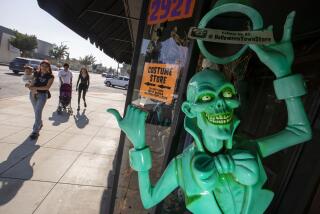Phobics Approach Holiday Season With Treatable Fear and Loathing
- Share via
MIAMI — For the millions of American who suffer from phobias and panic disorders, the approaching holiday season holds all the joy of an invitation to a lion’s den.
Afflicted with an intense irrational fear that produces debilitating physical symptoms, phobics become adept at avoiding the thing or situation that terrifies them. But the holiday season, with its round of parties, shopping and family obligations, can force them out into the open.
“During the year they can make excuses,” said Jerilyn Ross, president of the nonprofit Phobia Society of America. “Anything they’re afraid of and have to confront, it’s going to be aggravated now.”
“All of a sudden you have to go to the in-laws for dinner and they live on the 20th floor and you’re terrified of the elevator,” she suggested as an example. “Or you have your spouse buy all the presents because you can’t go into a crowded store, but now you have to buy a present for your spouse.”
The society estimates 24 million Americans, roughly one in 10, suffer from a phobia or panic disorder at some time in their lives, making it one of the most common of mental health problems.
It may be a single phobia--such as irrational fear of bridges, elevators, an animal or number--or a social phobia, the fear of a particular situation--parties, public speaking or crowded places.
“Most of us get invited to a party and think, ‘Wow, great.’ To a socially phobic person it would be like sending them an invitation to go to a lion’s den,” Ross said. “Being in a party atmosphere is a living nightmare for them.”
A Different Kind of Fear
Unlike normal fears and anxieties, phobias produce severe physical symptoms, the most common being palpitations, sweating, dizziness, trembling, hot and cold flashes, gasping for breath and faintness.
“There is a sort of misfiring. It’s a false alarm, a danger response when there is no danger,” Ross said.
Underneath it is a paralyzing fear of having a panic attack and losing control.
“It’s a fear of fear itself,” Ross said. “Will I start shouting obscenities? Will I pass out? Will I start to scream? Will I go crazy?”
The irony here is that phobics know their fears are irrational, which makes the fear itself all the more confusing.
Ross, a psychotherapist and associate director at the Roundhouse Square Phobia Treatment Center in Alexandria, Va., was a phobic herself, suffering from a fear of high buildings. Though she could ski mountains and ride chairlifts with ease, she was so terrified of high buildings that she avoided anything above the fifth floor for five years while living in Manhattan.
“Everything I did, everywhere I went, who I went out with was all planned around it, avoiding heights,” she said.
Researchers do not know what causes phobias. They usually start with a brief but intense anxiety attack, after which the victim becomes so frightened of a repeat episode that he or she avoids the place or situation where the attack occurred. Often, the attack is mistaken for a heart attack.
The average onset age is 24, and the tendency to develop phobias seems to run in families. There is a strong correlation with alcohol and drug abuse, but some researchers suspect that may be because phobics use them to calm the fear.
Social phobias are found equally among men and women, but single phobias including agoraphobia--a fear of open spaces--occur twice as often among women.
The good news is that phobias are among the most treatable mental disorders. The society estimated 75% to 90% of those affected can learn to function normally.
Yet only about 23% seek treatment because phobias often are misdiagnosed, and phobics may not know that treatment is available.
Cost a Factor
Others may fail to seek treatment because of the cost, although some insurance plans cover it. The typical 10- to 20-week therapy costs about $2,000 but is rarely available through public institutions.
Phobics usually are treated by gradually being exposed to that which causes their fear. For an agoraphobic, a therapist or members of a support group may accompany them on trips away from home until they are able to go out alone.
They learn to control the panic symptoms by breathing slowly and deeply, and by concentrating on the present.
“Mostly what they’re dealing with is anticipation anxiety, imaginary dangers of the future--’What if I pass out in the shopping mall. What if I go to the edge of the bridge and fall off,’ ” Ross said. “We get them to focus on the present by touching something physical, counting stripes on the wallpaper--anything that gets them back to the present.”
Group critiques or videotapes may be used to show the socially phobic that the blushing and knocking knees they fear are barely noticeable to others.
“Their perception is that everybody is seeing them,” Ross said. “They spend so much energy fighting the symptoms that they can’t think of anything else. Once they’ve learned how to deal with it, it isn’t a problem.”
Ross, who overcame her fear through exposure therapy and attended a “graduation” ceremony at a skyscraper rooftop lounge, was relieved to find that others shared her problem and that it could be treated.
“I felt like I was in a strange land and had finally met somebody who spoke my language,” she said.
For treatment information, send a self-addressed envelope with a 39-cent stamp to the Phobia Society of America, Dept. M, P.O. Box 42514, Washington, D.C., 20015.
More to Read
Sign up for Essential California
The most important California stories and recommendations in your inbox every morning.
You may occasionally receive promotional content from the Los Angeles Times.













